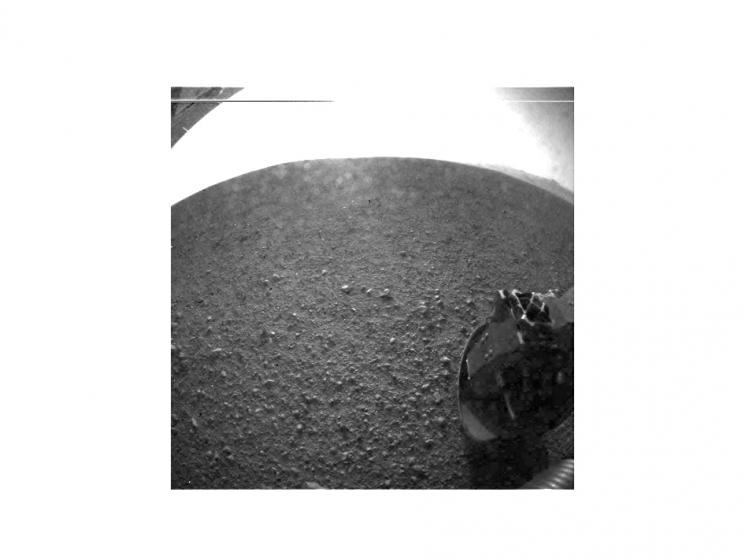
One of the first images taken by NASA's Curiosity rover was taken on the left-rear side of the rover looking directly into the sun. | Photo courtesy of NASA/JPL-Caltech.
This morning at 1:31 EDT the Mars rover Curiosity touched down on the Red Planet after a daredevil descent to begin its mission exploring a vast crater thought to have once held water.
Curiosity’s primary mission will be to gather geological and environmental data from the Martian surface to determine whether the planet has ever offered environmental conditions favorable for life -- and collect data for a manned mission.
It will do this by travelling around a particularly promising site called Gale Crater, which has three miles of exposed geological strata, or rock layers like we have in the Grand Canyon. By drilling into these rocks and sampling them, scientists can tell quite a bit about global processes that formed the planet -- including the role of water in its creation and the possibility of microbial life.
To do this, Curiosity is outfitted with a jackhammer at the end of a six-foot robotic arm to drill into rocks, and scoop the sample into its onboard spectrometer, which figures out its exact make up. For a quicker, hands-free approach, Curiosity can also fire its laser at a rock, vaporizing it in a visible flash of light. A sensitive device called the ChemCam, developed at Los Alamos National Lab, then reads the colors in the flash to determine its exact composition.
The one-ton, six-wheeled rover is twice as long and five times heavier than any other rolling science laboratory NASA has dropped onto the Martian soil so far. Previous rover missions to Mars had at most five experiments. Curiosity has 10 experiments, including the aforementioned rock-vaporizing laser. It also has a longer range than its predecessors. Another thing sets this rover apart from its predecessors -- Curiosity lacks solar panels.
Instead, a Multi-Mission Radioisotope Thermoelectric Generator (MMRTG) powers Curiosity. The device used in this mission was assembled and tested by researchers at Idaho National Lab with components from Los Alamos National Lab and Oak Ridge National Lab. Sandia National Laboratories performed the nuclear safety assessment. The device uses the same radioisotope technology that powers deep space probes like Pioneer, Galileo, Cassini, and other instruments intended to operate in the coldest, darkest reach of space outside our Solar System. The Energy Department's Office of Nuclear Energy and its predecessors have maintained the national capability to develop, manufacture and safely deliver radioisotope power systems for space exploration missions for more than five decades.
It was the technology of choice for Curiosity because as plutonium dioxide decays it gives off heat, which solves two problems of operating on the very cold, volatile surface of Mars. First, it heats the precise scientific instruments. With temperatures in the Gale Crater ranging from freezing (0 degrees Celsius) in the height of Martian summer and dropping well into negative double-digits at other times of the year, heat is important to keep the instruments within their operating temperatures.
Second, the MMRTG will provide a reliable 110 watts of power. The power system has a design life of 14 years, but all RTGs have exceeded their design life in the past. The MMRTG is not affected by Martian dust which was a problem with previous Mars rovers. During two potentially mission-shattering events during the Spirit and Opportunity missions, operators woke up the rovers to find their solar panels covered in dust. Running at reduced power, researchers could still perform their experiments, but it was slow going until wind swept their panels clean.
Nuclear-powered and decked out with a rock laser, courtesy of the Energy Department and its National Labs, Curiosity is by far the most sophisticated instrument we’ve loaded onto a rocket and launched into space. Today marks the beginning of its two-year mission on the Martian surface to determine the history of -- and our future with -- our neighboring Red Planet.





